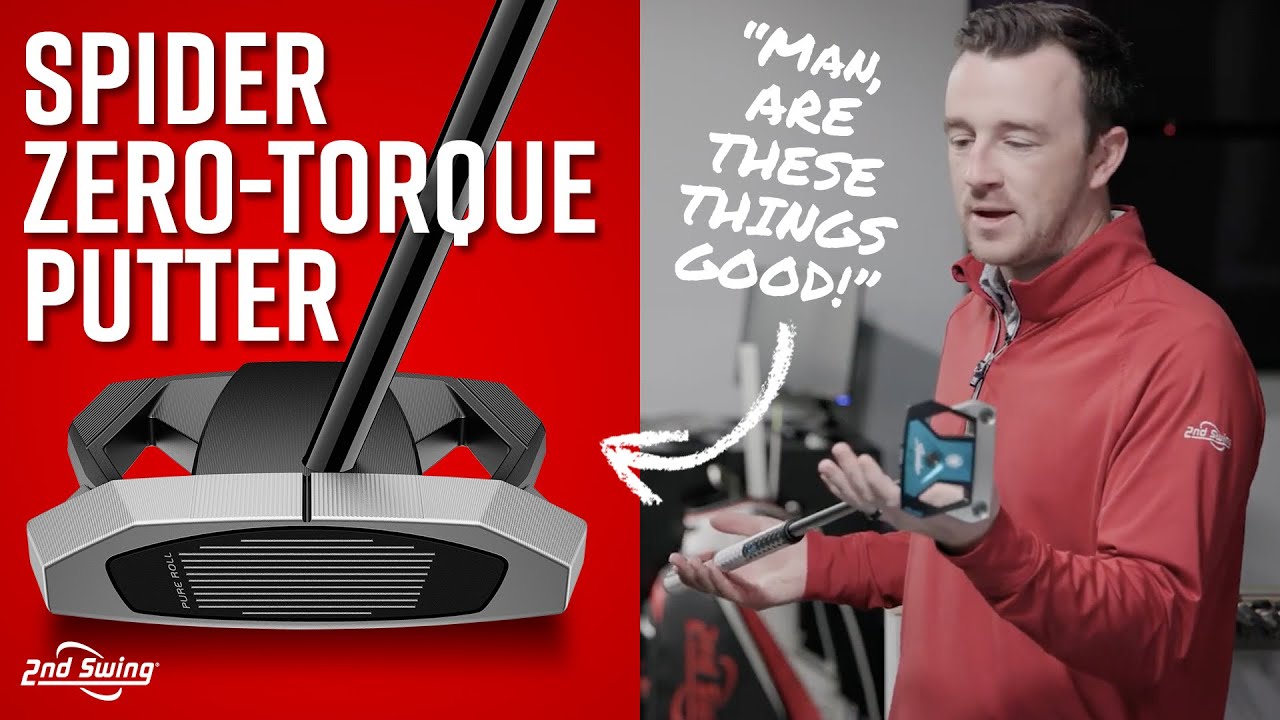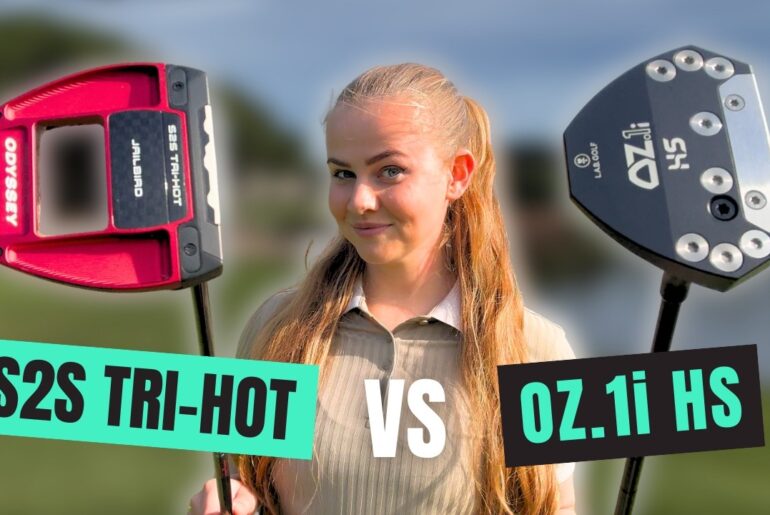The new TaylorMade Spider 5K-ZT Putter represents TaylorMade’s entry into the zero torque putter trend. It features some of the classic TaylorMade technologies that have been so successful for TaylorMade Spider putters, but in a Zero-Torque design that promotes a square clubface through the putting stroke.
In this video, 2nd Swing’s Drew Mahowald and master club fitter Tyler Fitzel get a first look at the TaylorMade Spider 5K-ZT putter and review all of the tech and discuss who the TaylorMade Spider 5K-ZT putter is best for.
Schedule an award-winning 2nd Swing fitting: https://www.2ndswing.com/golf-club-fittings
SUBSCRIBE to the 2nd Swing YouTube channel today for more in-depth golf equipment reviews and club fitting insights.
FOLLOW 2ND SWING GOLF ON SOCIAL MEDIA:
Facebook: https://www.facebook.com/2ndSwingGolf
X: https://X.com/2ndSwingGolf
Instagram: https://www.instagram.com/2ndswinggolf/
TikTok: https://www.tiktok.com/@2ndswinggolf
Hey golfers, I’m Drew Mahold of Second Swing Golf here in the tour van with Tyler Fitzell, master club fitter at Second Swing. We’ve got actually some putters that we’re going to talk through today. So, this is new adding into this trend of zero torque or low torque putters. Tyler, tailor made a new model. This is the Tailor Made Spider. Yep. 5KZT. And uh I first of all, I got to say I like the the color Yeah. scheme that they went with here with this kind of like teal turquoise color with the black. Um, but I just first before we dive into this model specifically, just tell me about this trend, what you’ve seen in, you know, fittings with golfers, what you’ve seen maybe in your own testing with the various models out there and now, uh, get kind of a first impression of this as well. Yeah, we’re seeing a lot of, um, low torque, zero torque type putter styles, um, that are being fit for. And one of the things that we’re looking at with that is trying to get ourselves into, let’s say, a better miss. Okay? When when we hit it perfect, when we’ve got the the ball right off the middle, the launch, the spinner, great with the putter, it’s on our line, it goes in the hole, we don’t have a lot to argue about. But it’s really where we maybe miss a slight bit. And that’s what all of these are about. They’re about stability. They’re about trying to control the amount of twisting that happens, whether it’s right on the sweet spot or not. And so these putter styles have taken off. They’ve been around slightly for a long time, but man are these things good. Yeah. Yeah. I think there’s a there’s an element now of some momentum catching on with these. There’s been some use on tour. People have taken notice of that and now it just seems like it’s snowball effect happening in the industry. So um what so what Tailor Made has done specifically here, there’s a KBS putter shaft that’s unique for this model. It is bored directly toward um near the center of gravity at a one degree shaft lean and there’s also 25 millimeters of onset. So that’s not super different than what you see in the industry, right? Um but that’s kind of how they create this zero torque or low torque design. So now if you hold up the putter like this, obviously the toe up is the idea and it kind of has that, you know, it keeps the putter face as square as possible through the stroke a little bit differently than, you know, a putter with the shaft into the heel. So, um, kind of talk to me what exactly is going on with this like like how what’s the science behind that and how it works? Well, so there’s three things that happen with every single uh club and especially when we start talking about putters. So, we we can have loft where we adjust the loft with our hands. We have lie angle and then we have rotation. And I I like to kind of call it the fourth dimension. Uh rotation’s the one that kind of gets left off. We think about, you know, up, we think about down, we think about out. But the rotation piece, every single putter of some sort has to have some sort of opening and closing. We don’t actually take it straight back and straight through. It’s the It’s maybe our goal in the movements that we make. This just helps to create a bit more straight back, straight through. It helps to create less twisting and offcenteredness. Yeah. And so in addition to all that technology, there’s a lot of that the traditional tailor made spider uh features here as well. So you have that high MOI design, right? A lot of weight behind the club face and sort of out to the perimeter. Um you also have actually a new sole shape or there’s a little bit of curvature here. You can see just a tiny bit there right behind leading edge. Uh it’s supposed to the idea is to help with various different putting strokes, not just kind of what we call a straight back straight through but something with a little bit more arc to it. You also have uh some alignment there. Some this this line up here right behind the club face. And then you also have their uh what they call pure roll face insert which has been a staple in tailor made spider families for many for a long time. And then uh one thing you pointed out as well is this this grip. So we have a onederee offaxis grip um especially in the standard uh in the standard length offering. So talk to me about what that means and what uh it’ll do for for golfers. So, we talk about the shaft lean as one of those pieces, but then we also talk about the grip. And you can kind of see is that there’s a little bit more space on this side of the grip than this side of the grip. And likewise, if you’re looking down, you can see that that that there’s more grip on that side. And what it does is it helps to try to offset a little bit of the loft. So, one of the things we don’t want to do is we don’t really want to get the club head moving past our hands and get the loft up. That that’s kind of this launch and spin killer. It’s it’s really the hardest part about putting is trying to keep our hands in a certain position. So, what this does is start to preset that, get our hands in in a position where the amount of loft on the putter creates a really good launch and spin. Mhm. Yeah. And then there’s three configurations we have here. So, uh you’ve got that sort of standard, right, which is available at 34 or excuse me, 33, 34, or 35 in with the grip that you mentioned. Also available in both right-handed and left-handed. That’s the counterbalance option. Um, so you’ve seen these around in that 36, 37, 38, 39 inch variations. Specifically with Tailor Made in this one, there’s 36 and 38 inches available. Yep. You got that kind of thicker superstroke grip there. And then lastly, you have what they call the long version, which is kind of that sweeper style, if you will, um, which is actually the stock length is 46 in. So, um, there’s all these variations available. And the last thing I want to do here as we sort of, you know, wrap up this quick segment is just who are these putters for? And you can talk about the variations of the the the setups or we can just talk about in particular the technology and and the design of who’s it for, but um you know obviously a lot of golfers are going to be fit into this throughout the year in 2025. So talk to me about um what types of golfers we’re talking about. So if you have a miss that tends to go on either side of this, we maybe want there’s a little too much rotation or not enough rotation happening from a putt to putt, that’s one of the the golfers that we’re talking about. So, if you kind of have this mist that’s either right or left, this can help stabilize that a little. Um, the other part of this too is with the toe up technology where we see that weight, this also has a tendency not to go left. This is a bit more of a fade, call it a fade bias putter that, but that’s really kind of the intent of this is when we’re talking about rotation, how much rotation happens and then when it when it uh creates impact, uh, it wants to stabilize itself. So, that’s where the waiting is there to begin with. You know, we talk a lot about putters where you say you have um you know, a really strong arc or you really really open and close it. Well, not a lot of people kind of close it to open it. And this is really that other side. This technology has been around for many years with this kind of tow up technology. So, if if you have if you have a real tendency to to close down hard or pull a putt, this is one will do wonders for you. Yeah. I mean, there’s putters out there in terms of tow hang, right? where this one obviously has to up, but you’ll see some putters where actually they flop all the way to the other side. This is kind of the opposite end of that spectrum in terms of the putting stroke and what it’s trying to do to fight your maybe your tendencies. So, but yeah, so this is a tailor made spider 5K ZT putter. We talked about all the features, we talked about the tech. Um, now it’s about getting fit. So, if you I mean like the look of this thing, if you think it might be something for your game, schedule a fitting with Tyler or any one of our fitters. We’ll get you dialed in and hopefully making some more putts out there. So, Tyler, thank you for joining. Yeah, thanks. [Music]








6 Comments
Can the lie angle be adjusted on these?
Time for a few comparison videos
I think Taylormade should have priced this similar to Odyssey's square 2 square line in order to better compete against Odyssey & LAB.
Maybe it costs more to produce a blue headcover than a black one? LOL
I don’t understand why he says this is good for a left miss. Isn’t it a toe up putter—hence heel weighted/balanced? I had opposite experience with my Odyssey S2S. I had right miss and it really helped correct. Also, way to correct driver slice/right miss is to add more weight in heel. Is this tech different?
Looks great
Taylormade didn’t put out good notes on don’t call these toe up😂